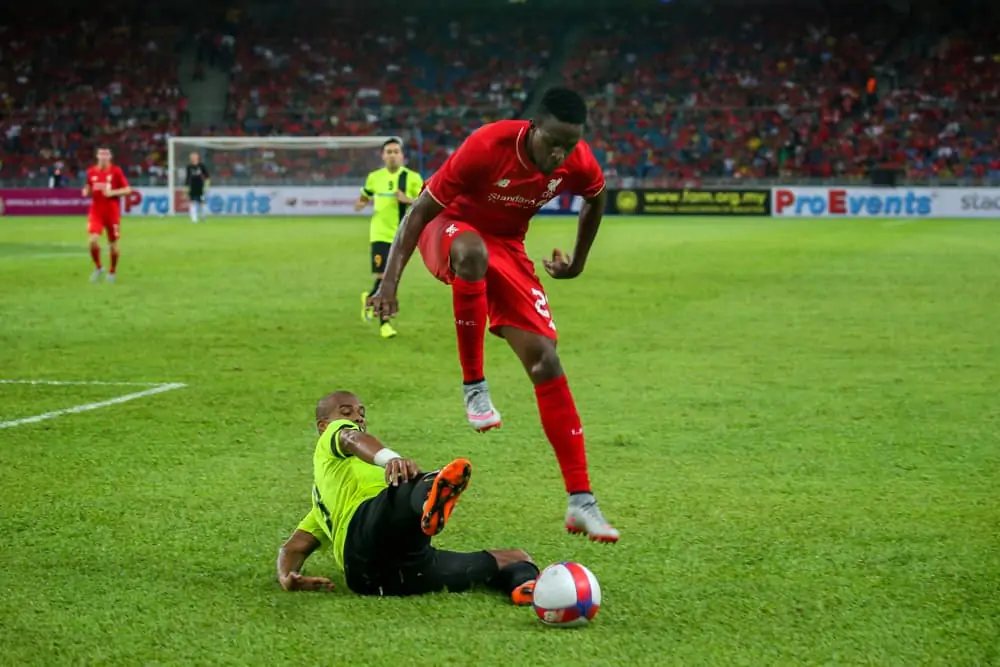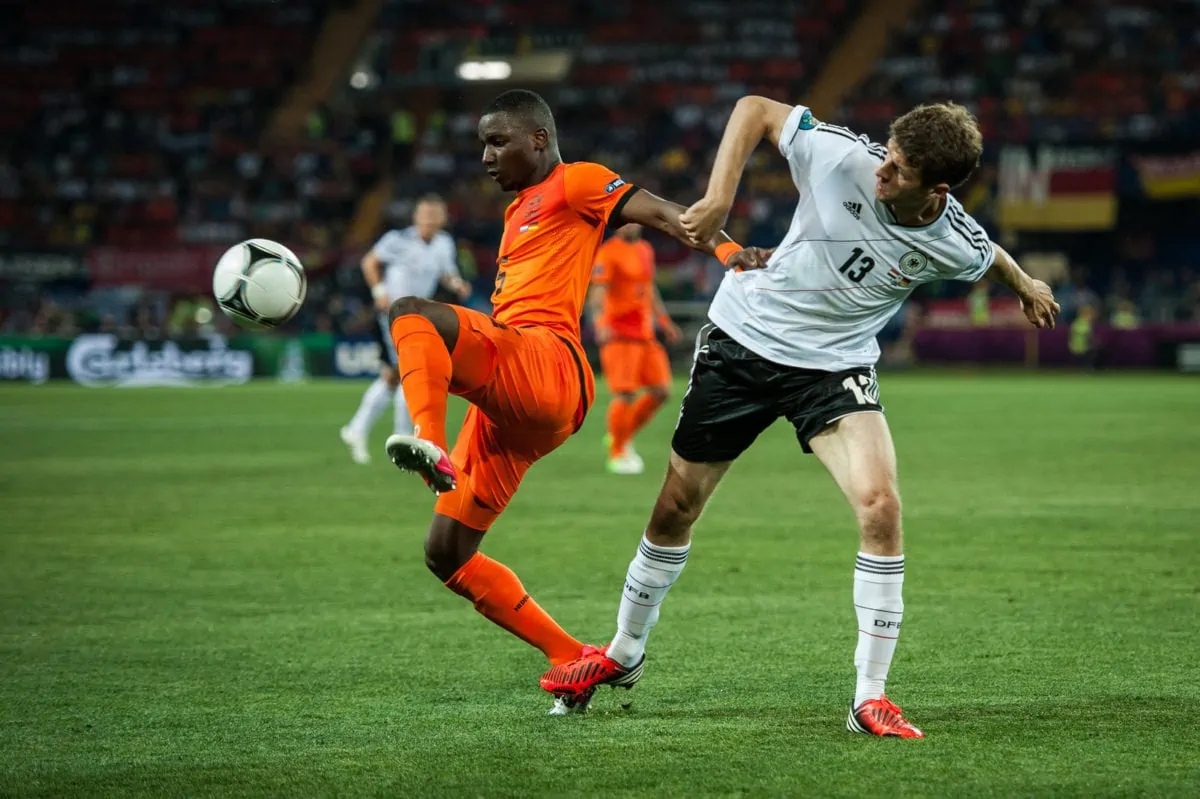Share the post "Play Soccer Without Fear (Confidence Methods)"
In soccer, anxiety or a lack of confidence can stop you from playing without fear. We all feel anxious sometimes, and our confidence can be low for various reasons. It’s normal.
In this article, we’ll give tips for playing soccer without fear.
Some key points we’ll cover today are:
- Practice and visualization
- Put mistakes out of your mind
- Have fun
If you’re feeling anxious when playing soccer, don’t worry because it’s normal, and you can overcome it with our tips.

How to play soccer without fear
You can play soccer without fear by following these 5 tips:
- Practice with purpose
- Positive visualization
- Don’t dwell on mistakes
- Believe in yourself
- Have fun
Before we go further with these 5 tips, let’s look at a quick example of a soccer player getting anxious before a game.
- Cristiano Ronaldo, one of the greatest players of all time, was ‘super nervous’ before his second Manchester United debut.
This is a player who has won countless individual and team awards. Despite his success, he still got super nervous before the game against Newcastle United.
So, don’t worry if you’re feeling nervous before a game. It happens to the best players as well.
How you deal with it counts, and we’re here to help with our 5 tips for playing soccer without fear.

1. Practice with purpose
Concentrating on a particular part of your soccer game to practice purposefully would be best. Maybe you’re a defender and get anxious when an attacker dribbles toward you. In that case, you’ll want to practice that situation.
Identify situations that you’re afraid of and practice them.
Think about what gives you the most fear on the soccer field. During practice, put yourself in that situation repeatedly. This repetition will allow you to become comfortable in those fearful situations.
Imagine that having the ball when you’re surrounded by opposing players is your biggest fear on the soccer field. To overcome that fear, repeatedly practice in that situation.
Play Keep-Ball
In training, get your teammates to surround you and try to get the ball from you. Or get your friends to do it when you practice at home.
The more you practice this fearful situation, the more comfortable you’ll become.
Practicing with purpose will lessen your anxiety. And with repetition, you’ll improve in that situation, increasing your confidence.
So, identify the situation that you’re afraid of. Then, practice with purpose in these scenarios. That’ll help you to play soccer without fear.

2. Positive visualization
Positive visualization is forming images in your mind that have a positive outcome. So, if you want something to happen, positive visualization is imagining it.
Think of it as positive pictures or a positive video in your mind. Now, let’s use taking penalties as an example. Taking a penalty in a game might be your biggest fear in soccer.
You can use positive visualization to help you overcome that fear. It’s best to combine this with our first tip: practice with purpose.
But you can visualize anywhere, too. You can visualize taking penalties and scoring every time in the car or bus on the way to training.
Always ensure you visualize a positive outcome – scoring the penalty in this case.
When practicing penalties, visualize where you want the ball to go before hitting it. If you want to hit it low into the corner to the goalie’s left side, imagine that happening in your mind.
Focus
Focus on the image of the ball going exactly where you want it.
Once you’re focused through positive visualization, take the penalty. When you’re practicing, keep these 2 things in mind:
- Positive visualization and execution.
That means you visualize where the ball will go and kick it there. Don’t worry if you can’t kick the ball exactly where you want. It takes practice.
Visualize
But if you practice positive visualization and execution, you’ll keep getting better. With enough time and practice, you’ll be able to pick your spot and put the ball there.
Then, when you go to take a penalty during the game, you’ll be prepared. Just do what you’ve been practicing.
Imagine the ball going into the goal and stepping up and executing. Positive visualization can also be used for other situations in soccer, not just taking penalties.
Think about what you’re afraid of on the soccer field. Then, visualize a positive outcome and execute it. It’s a great way to become comfortable and play soccer without fear.

3. Don’t dwell on mistakes
If you make a mistake, don’t keep thinking about it. Realize you made a mistake but then move on from it. Put it out of your mind.
It’s essential to realize what you did wrong. That means you can adjust so the same mistake won’t happen again. But don’t get hung up on the mistake.
- If you keep thinking about a mistake, you will likely make even more.
Everyone makes mistakes, it’s part of being human. And soccer players make mistakes on the field, too.
Example
Let’s take Ronaldo’s return for Manchester United against Newcastle United as an example again. As we already know, Ronaldo was super nervous before the game. And when he got his first chance to shoot on goal, he made a mistake.
When Ronaldo went to shoot, he almost missed the ball completely and fell on his butt. He made a mistake in front of thousands of fans.
But Ronaldo is an experienced player who knows that mistakes are part of soccer. He got up from the ground and laughed off the mistake. He was likely thinking: No big deal. I’ll get more chances to score.
- And he did. Manchester United won 4-1, with Ronaldo scoring 2 goals. So, if you make a mistake, don’t dwell on it.
Follow Ronaldo’s example. Put the mistake out of your mind and get on with the game.
Just because you made a mistake one time doesn’t mean you’ll do it again. Realize your mistake and move on. Maybe you’ll score the winning goal with your next chance.

4. Believe in yourself
If you’re anxious and lack confidence, think about your training and believe in yourself. You’ve put in the practice.
- Trust your training and believe you can do it during a game.
All the best players have high self-belief. That’s because they’ve put in the work in the training field. They know they’ve done the practice and are prepared for the game.
People who work with Ronaldo and Messi always say that both players are the first at training and the last to leave. They put in the work. That allows them to believe in themselves.
So, follow their example.
Put in the work and believe in yourself.

5. Have fun
To play without fear, have fun during a game. Have you ever played a fantastic game and realized you were having a lot of fun on the field? It’s likely you played well because you were having fun.
When you’re having fun, you’re not putting pressure on yourself. You can laugh off a mistake as Ronaldo did.
A lot of us play soccer because we love the game. It’s fun!
If you’re feeling anxious before a game, remember that soccer is fun. Remember why you like to play the game in the first place. Use your love for soccer to overcome any fears. Just go out on the field and have fun.
You’ll likely realize that having fun allows you to play soccer without fear.
Those are our 5 tips for playing soccer without fear. Combine your purposeful practice with visualization to prepare you for games. Once it’s time to play, don’t dwell on any mistakes, and believe in yourself.
And most importantly, have fun.
Share the post "Play Soccer Without Fear (Confidence Methods)"
Joel is a seasoned soccer journalist and analyst with many years of experience in the field. Joel specializes in game analysis, player profiles, transfer news, and has a keen eye for the tactical nuances of the game. He played at various levels in the game and coached teams - he is happy to share his insight with you.



